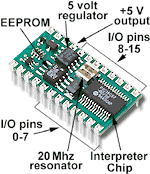

 |
BASIC Stamps are small computers that run Parallax BASIC (PBASIC) programs. They have fully programmable I/O pins that can be used to directly interface to TTL-level devices, such as buttons, LEDs, speakers, potentiometers, and shift registers. And with just a few extra components, these I/O pins can be connected to non-TTL devices, such as solenoids, relays, RS-232 networks, and other high current/voltage devices. |
|
Though they are available in various physical packages, all versions of BASIC Stamps have the same logical design, consisting of a 5-volt regulator, resonator, serial EEPROM, and PBASIC interpreter. A tokenized PBASIC program is stored in the non-volatile serial EEPROM, which is read from and written to by the interpreter chip. This interpreter chip fetches the instructions one at a time and performs the appropriate operation on the I/O pins or internal structures within the interpreter. Because the PBASIC program is stored in an EEPROM, it may be programmed and reprogrammed almost endlessly, without the need to first erase the memory, as with most PICs. To program BASIC Stamps, you just connect them to an IBM PC or compatible and run our editor software to edit and download your program. |
 |
The BASIC Stamp I has 8 I/O pins, holds 80 to 100 instructions and executes an average of 2000 instructions/sec. The BASIC Stamp II has 16 I/O pins plus two synchronous serial pins, holds 500 to 600 instructions and executes an average of 4000 instructions/sec. For more information on size and configuration, view our BASIC Stamp Comparison data.
 |
| For more answers to common questions, download the BASIC Stamp Frequently Asked Questions (FAQs) list. It contains approximately 70 common BASIC Stamp questions and answers. |
![]()
Please send your comments about our website to the Parallax Webmaster